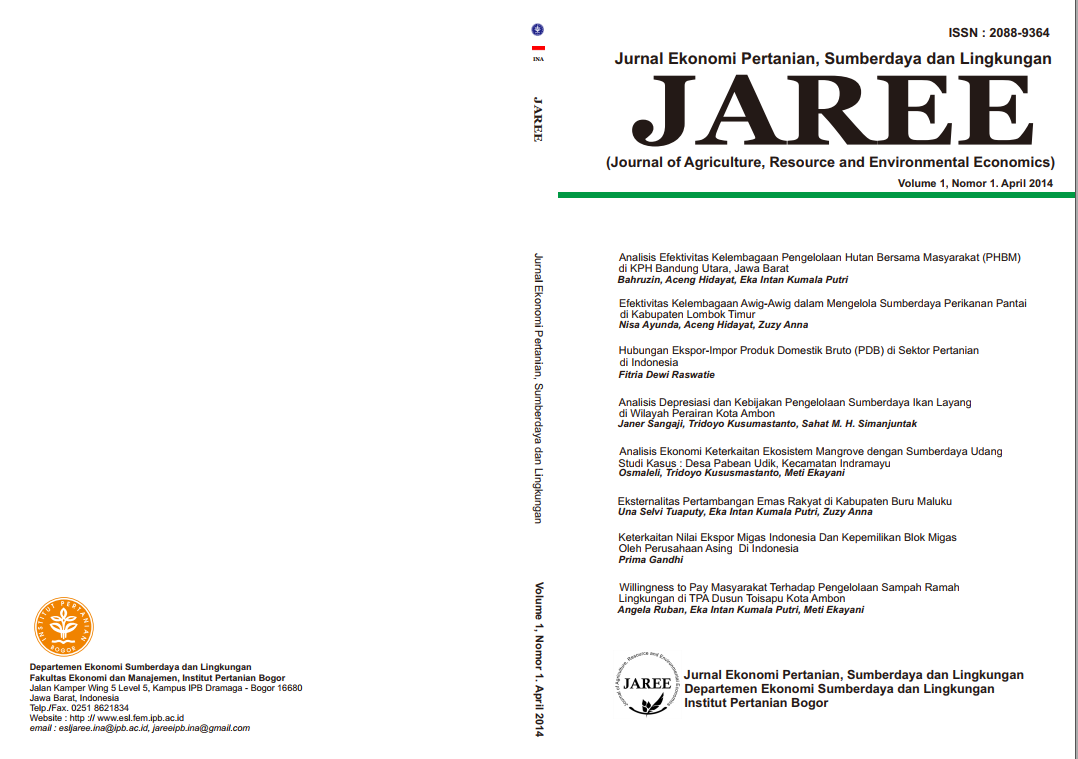Willingness to Pay Masyarakat Terhadap Pengolahan Sampah Ramah Lingkungan di TPA Dusun Toisapu Kota Ambon
Abstract
Toisapu Village Landfills in Ambon has been established since 2003 using open dumping system in processing the waste. These activity has caused negative externalities for the people living around the landfill. This paper aimed to analyze the factors that affected people's willingness to pay a higher levy for better waste management, the amount of the retribution to pay, and the closure of the operational costs through the analysis of willingness to pay (WTP) with four scenarios offered in the Baguala and Nusaniwe Regencies. The results showed that the factors affecting people's willingness to pay a higher retribution in the Baguala and Nusaniwe regencies were the level of education and the distance between their home and landfill. The highest average of WTP in Baguala regency of biogas scenario was Rp 24.250/ KK/ month, and the lowest in the incineration scenario was Rp 20 804/ KK /month. While in the Nusaniwe regency, the highest average of WTP obtained was Rp 21 228/ KK/ month in composting scenario, and the lowest was of Rp 18 220/ KK/ month in sanitary landfill scenario. The value of society WTP obtained was the value of retribution to pay, and this value could cover the operational costs required to implement the four scenarios of waste management offered.
Downloads
References
Alberini, A. Rosato P. and Zanatta, V. 2005. Combining Actual and Contingent Behaviour to Estimate The Value of Sport Fishing in The Lagoon of Venice. Ecological Economics Vol. 61, No. 2-3, pp. 533-541.
Alkadri, D. Muchdie. dan Suhandojo M. 1999. Tiga Pilar Pengembangan Wilayah. Badan Pengkajian dan Penerapan Teknologi (BPPT), Jakarta.
Assamoi, B. dan Lawryshyn Y. 2012. The Environmental Comparison of Landfilling vs. Incineration of MSW Accounting for Waste Diversion. Waste Management, Vol. 32, No. 3, pp. 1019-1030.
Badan Pusat Statistik. 2013. Kota Ambon dalam Angka. BPS, Kota Ambon.
Dainur. 1995. Materi-Materi Pokok Ilmu Kesehatan Masyarakat. Widya Medika, Jakarta.
Dhany, R.R. 2014. Harga Elpiji yang Wajar. (http://finance.detik.com/read/harga-elpiji-yang-wajar/) diakses 14 Maret 2014.
Dijkgraaf, E. and Vollebergh, H.R.J. 2003. Burn or Bury? A Social Cost Comparison of Final Waste Disposal Methods. Social Science Research.
Dinas Kebersihan dan Pertamanan. 2013. Volume Sampah di Kota Ambon. DKP, Kota Ambon.
Dinas Kebersihan dan Pertamanan. 2013. Total Penerimaan dari Retribusi. DKP, Kota Ambon.
Ding, N. dkk. 2013. Decline in Extractable Kitasamycin During The Composting Of Kitasamycin Manufacturing Waste With Dairy Manure and Sawdust. Journal of Environmental Management, Vol.134, No.1, pp. 39–46.
Fauzi, A. 2001. Prinsip-Prinsip Penelitian Sosial Ekonomi : Panduan Singkat. Jurusan Sosial Ekonomi Perikanan dan Kelautan. IPB Press, Bogor.
Fauzi, A. 2004. Ekonomi Sumber Daya Alam dan Lingkungan. Gramedia Pustaka Utama, Jakarta.
Gajalakshmi, S. Dan Abbasi, S.A. 2008. Solid Waste Management by Composting: State of the Art. Critical Reviews in Environmental Science and Technology, Vol.38, No. 4, pp. 311-400.
Handono, M. 2010. Model Pengelolaan Tempat Pemrosesan Akhir (TPA) Sampah Secara Berkelanjutan di TPA Cipayung Kota Depok, Jawa Barat. Disertasi. Institut Pertanian Bogor, Bogor.
Harihastuti N. 2007. Proses Penghancuran (Insinerasi) Sebagai Alternatif Pengolahan Limbah Padat (Studi Kasus di PT. Kayu Lapis Indonesia – Kaliwulung Kab. Kendal. Tesis Master Sains. Program Pascasarjana Universitas Diponegoro, Semarang.
Hosmer, D.W. dan Lemeshow, S. 1989. Applied Logistic Regression. John Wiley & Sons Inc, New York.
Kahneman, D. dan Ritov, I. 1994. Determinants of Stated Willingness to Pay for Public Goods: A study of The Headline Method. Journal of Risk and Uncertainty, Vol. 9, No. 1, pp. 5-38.
Latief, A.S. 2010. Manfaat dan Dampak Penggunaan Insinerator Terhadap Lingkungan. Jurnal Teknik Mesin Politeknik Negeri Semarang, Vol. 5, No. 1, pp. 20-24.
Manios, T. and Stentiford, E.I. 2003. Sanitary Aspect of Partially Treated Landfill Leachate as a Water Source In Green Waste Composting. CalRecoveery, Inc., CA, USA.
Meade, J.E. 1973. The Theory of Economic Externalities: The Control of Environmental Pollution and Similar Social Costs. Brill Archive, UK.
Meggyes, A. dan Nagy, V. 2012. Biogas and Energy Production by Utilization of Different Agricultural Wastes. Acta Polytechnica Hungarica, Vol. 9, No.6, pp. 65-80.
Moersidik, S.S., 2013. Hunian, Infrastruktur, Kota dan Lingkungan. KIPRAH, Vol. 54, No.1, pp. 62-65.
Mooney H., Larigauderie A., Cesario M., Elmquist T., Hoegh-Guldberg O., Lavorel S., Mace GM., Palmer M., Scholes R., Yahara, T. 2009. Biodiversity, Climate Change, and Ecosystem Services. Current Opinion in Environmental Sustainability, Vol. 1, No.1, pp. 46-54.
Pearce, D. Atkinson, G. dan Mourato, S. 2006. Cost-Benefit Analysis and the Environment: Recent Development. OECD, Paris.
Republik Indonesia. Undang-Undang No. 18 Tahun 2008 tentang Pengelolaan Sampah.
Soma, S. 2010. Pengantar Ilmu Teknik Lingkungan (Seri : Pengelolaan Sampah Perkotaan). IPB Press, Bogor,
Sumarwoto, O., 2001. Ekologi, Lingkungan Hidup dan Pembangunan. Djambatan, Jakarta.
Usman, M.A. Olanipekun, O.O. dan Kareem, O.M. 2012. Biogas Generation from Domestic Solid Wastes in Mesophilic Anaerobic Digestion. International Journal of Research in Chemistry and Environment, Vol. 2, No.4, pp. 200-205.




